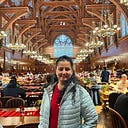Paradise On Earth, Here It Is.
I came to Whistler with my family in the summer of 2020. Many times in these months, when I have looked out of my window, my thoughts have wandered to my ancestors.
Several thousand years ago, they migrated to India from somewhere near the Caucusus ranges. Crossing into the subcontinent across treacherous terrain and harsh Himalayan peaks, unlike much of their clan, a small group called the Kayasthas settled down. They thrived for many centuries in the Kashmir Valley, eventually migrating family by family to various parts of present-day India.
Amir Khusrao, the famous 13th-century Persian poet, visited Kashmir wrote in his native Farsi, “Gar Firdaus Barru-e Zaminast, Haminasto, Haminasto, Haminasto”. Translated into English it means, if there is paradise on Earth, here it is, here it is, here it is.
As a kid, I often wondered if I would ever be able to visit this so-called paradise. I wasn’t so driven to find my roots as I was by the desire to witness that fabled alpine beauty. The natives of the lower foothills, the “pahadi” people believe, “You don’t decide to visit the Himalayas. They must invite you.” And I wasn’t sure when the Kashmiri Himalayas were going to invite me because Kashmir has been volatile and inaccessible to tourists, for several decades due to political conflict.
You might wonder how all of this relates to my move to Whistler, on the other side of the planet? Whistler and I first met in her forests. When I walk in these mystical forests, they feel otherworldly. A sense of hiraeth descends upon me; is this how the alpine forests in Kashmir must have seemed to my forefathers many centuries back?
I have had an astonishing variety of sublime experiences here. In the summer, on my runs down the Valley trail, I’ve watched cool breeze flow over the Green Lake, making the reflection appear like a Monet painting for a few seconds. In the fall, my mountain appears to have just returned from a hair salon with blonde highlights. On rainy days, I’ve noticed bustling life waiting to be discovered under each rock and on every stump along drenched trails.
And have you ever watched the moon rise over the valley between Wedgmont and Blackcomb on a cold, crisp night? Just after midnight, when the temperature drops, a large cloud forms over that valley and the lake. The moon lights up that cloud with an ethereal, milky glow. My eyes took in that view, and out flowed an entire poem!
In winter, just after the flurries, it seems as though there is a dusting of icing sugar on every tree, branch, and needle. Seen from the Peak2Peak Gondola, as you ascend above the veil, this carefully snow-dusted world below seems to vanish under a meandering river of clouds. The veil now looks like a never-ending cape. Glowing under the sun that is preparing to set, it turns a pale orange all the way from the Tantalus range to the mountains towards Pemberton. If Big Foot lived here, I wouldn’t blame him for never bothering to wonder if anyone existed below.
I may or may not be able to visit Kashmir, who knows? But halfway across the world, I’m putting down roots in this quaint ski town. Recently, I discovered, to my surprise that the exotic chinar trees that the Kashmir valley is well-known for across the Indian subcontinent, are part of the Maple family. I’ll take it as a sign. Perhaps, a long-held dream is coming true.
I am falling in love with paradise. I’m sure Amir Khusrau would agree — if there is paradise on Earth, haminasto haminasto haminasto. Here it is, here it is, here it is.
A version of this article first appeared as a First-Person essay in The Globe and Mail, Canada’s national newspaper.
